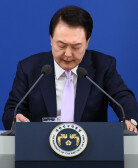Bias of new history textbooks
New high school history textbooks to be used from this spring semester retain left-leaning descriptions of Korean history. The six types of history books have been published under new standards since the launch of the conservative Lee Myung-bak administration. They disappoint many who expected history textbooks to present a balanced view of history based on the Republic of Korea`s identity, however. The textbooks made progress in that they defined the 1950-53 Korean War as a conflict caused by North Koreas invasion of South Korea and highlighted the legitimacy of the Republic of Korea. They must, however, correct left-leaning descriptions of events in the South`s modern history as soon as possible.
A Korean history textbook that the Education, Science and Technology Ministry plans to require for high school students summarizes Koreas ancient history. Much of the textbook is devoted to the countrys modern history. The textbook is virtually a new version of lectures on Koreas modern history given to high school students. The government has said several times that new history textbooks will overcome left-leaning biases in textbooks that depict Koreas modern history from the perspectives of left-leaning nationalists and populists. The ministry has failed to do so, however.
The new textbooks describe questionable items as if they are true. Certain textbooks describe the 12 reform proposals made by the Donghak army in the 1894 Donghak Peasants Rebellion as being from a novel. Among the 12 proposals in the textbooks, the one on equally dividing land for cultivation appears in none of the Donghak armys declarations or appeals. The textbooks also carry the Picasso painting Massacre in Korea. Though the painting is based on the mass killing of civilians in Sincheon, Hwanghae Province, in the Korean War, whether the killing was committed by U.S. troops as Picasso thought remains unconfirmed.
Several of the textbooks still describe North Korea favorably. The North had a bigger responsibility for the division of the Korean Peninsula because it established a de facto government in February 1946 even before South Korea began to talk about setting up its own government. Yet the textbooks fail to mention this. They also provide clear descriptions of where massacres of civilians involving South Korean troops took place while simply noting that the North Korean militarys killings of civilians occurred in various places. None of the textbooks describe the human rights abuses in the North and the food crisis and mass starvation caused by the failure of its communist system.
While education on Korean history should be strengthened at a time when more South Koreans are deficient in history knowledge, such textbooks could fuel negative sentiments about the history of the Republic of Korea. The Education Ministry should have published proper history textbooks before rushing to designate Korean history as a required course.







